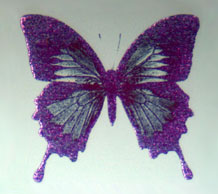
A butterfly image drawn with the new technology (credit: Oxford University)
Researchers discover ‘Nano-pixels’ that promise thin, flexible high-res displays
A new discovery will make it possible to create pixels just a few hundred nanometres across that could pave the way for extremely high-resolution and low-energy thin, flexible displays for applications such as ‘smart’ glasses, synthetic retinas, and foldable screens.
A team of UK scientists, including Professor David Wright from the University of Exeter, explored the link between the electrical and optical properties of phase change materials (materials that can change from an amorphous to a crystalline state).
They found that by sandwiching a seven nanometre thick layer of a phase change material (GST) between two layers of a transparent electrode they could use a tiny current to ‘draw’ images within the sandwich ‘stack’.
Initially still images were created using an atomic force microscope but the team went on to demonstrate that such tiny ‘stacks’ can be turned into prototype pixel-like devices. These ‘nano-pixels’ – just 300 by 300 nanometres in size – can be electrically switched ‘on and off’ at will, creating the coloured dots that would form the building blocks of an extremely high-resolution display technology.
A report of the research is published in the leading scientific journal, Nature.
Professor Wright, from Exeter’s Engineering Department and co-author of the work, said: “Along with many other researchers around the world we have been looking into the use of these GST materials for memory applications for many years, but no one before thought of combining their electrical and optical functionality to provide entirely new kinds of non-volatile, high-resolution, electronic colour displays - so our work is a real breakthrough'.
The layers of the GST sandwich are created using a sputtering technique where a target is bombarded with high energy particles so that atoms from the target are deposited onto another material as a thin film.
Professor Harish Bhaskaran, formerly of Exeter and now part of Oxford University’s Department of Materials and who led the research said: “We didn’t set out to invent a new kind of display. We were exploring the relationship between the electrical and optical properties of phase change materials and then had the idea of creating this GST ‘sandwich’ made up of layers just a few nanometres thick.
“We found that not only were we able to create images in the stack but, to our surprise, thinner layers of GST actually gave us better contrast. We also discovered that altering the size of the bottom electrode layer enabled us to change the colour of the image.”
Peiman Hosseini of Oxford University’s Department of Materials and a former PhD student at Exeter added: ‘Our models are so good at predicting the experiment that we can tune our prototype ‘pixels’ to create any colour we want – including the primary colours needed for a display. One of the advantages of our design is that, unlike most conventional LCD screens, there would be no need to constantly refresh all pixels, you would only have to refresh those pixels that actually change (static pixels remain as they were). This means that any display based on this technology would have extremely low energy consumption.’
The research suggests that flexible paper-thin displays based on the technology could have the capacity to switch between a power-saving ‘colour e-reader mode’, and a backlit display capable of showing video.
The research was supported by the UK’s Engineering and Physical Sciences Research Council (EPSRC).
Date: 10 July 2014
